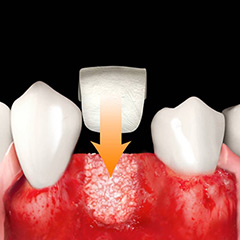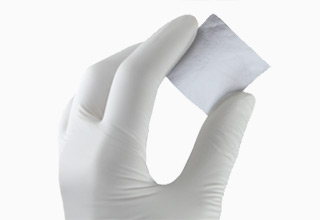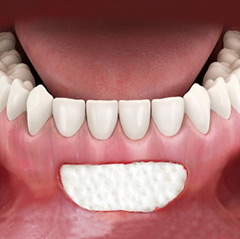Exposé Series - Resorbable Membranes
|
Membranes are a vital part of GBR procedures and serve several purposes. Not the least of which are separating the invasive soft tissues from the graft site and assisting with the graft shape. With many types of membranes available, here are a few insights into the range of resorbable membranes from OsteoBiol. |
|
On the Fence: To resorb or not to resorb? 
Nonresorbable membranes are often used in larger grafting procedures. They offer excellent indefinite stability and without membrane exposure during healing, have resulted in good outcomes. However bioresorbable membranes exhibit lower dehiscence rates compared with PTFE nonresorbable membranes. Furthermore, eventual removal of a nonresorbable membrane necessitates a second extensive surgical re-opening. (Wessing et al. 2016) The introduction of a semi-rigid resorbable membrane has filled the gap between a rigid titanium membrane, and the maleable collagen membrane. The Lamina membrane from OsteoBiol is composed of 100% cortical bone, and can be shaped with sterile scissors. The desired level of flexibility can be achieved with hydration before being fixated to the grafting site with titanium screws or sutures. The 25x35mm fine model in stock has a re-entry time of about 5 months and is available for $280, with a range of other models available via special order. Clinical images of a reconstruction case were recently posted by Samvel Bleyan showcasing Lamina. |
|
What about soft tissues?
One of these alternatives is the Derma membrane from OsteoBiol. Derma is now available in two sizes, a 25x25mm fine as well as the original 30x30mm standard. The thinner fine varient is already becoming popular as it is easier to handle and can be used to treat both mild gingival recessions and to improve the quality of keratinized tissues (Fischer et al. 2014). We are offering these at just $130 each for either the 25x25mm fine or the 30x30mm standard Derma membrane. |
|
What is the most popular? Our most popular membrane of all is easily the versatile 20x20mm fine Evolution. Just like Lamina and Derma, in cases of accidental exposure Evolution is able to protect the graft from infection, and not be infected itself, allowing second intention healing (Barone et al. 2013). Evolution exhibits excellent handling characteristics and is made of dense collagen fibers of high consistency and resistance. Evolution is also available in both fine or standard, and porcine or equine variants. Browse the Evolution range now... More information on the membranes discussed, along with the full range available, can be found on OsteoBiol.com |


